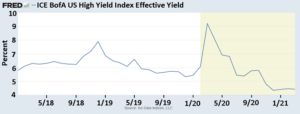Over the last few quarters this update has addressed how different real estate product types have weathered the pandemic storm and how the Washington submarkets, with their unique proximity to the Federal enclave have performed. As America gets vaccinated and the economy begins to recover, we thought it would be interesting to explore how the capital markets are responding and how real estate might fare. While there will be distressed opportunities as we experience a shift in the way we work, shop and play, the anticipation of a strong recovery may shorten the duration of that distressed period.
One of the anomalies of the past year has been the consistency of cap rates. One would expect cap rates to rise during a period of economic contraction, not to mention the once in a century pandemic, yet that has not happened, except in the most distressed asset classes such as hospitality and some retail formats. For the most sought-after asset classes – apartments, industrial, self-storage, data center, and life sciences – cap rates have fallen, pushing values up to and sometimes through pre-pandemic levels. It appears likely that cap rates will remain low for certain assets as the economy builds momentum coming out of the recession.
One of the reasons for the downward pressure on cap rates is the abundance of equity and debt available for real estate investment. There continues to be significant dry powder in dedicated real estate investment funds, and in the DC Region, we are seeing an increase in buying from high-net-worth investors both domestic and international. Capital in real estate debt funds has grown by 40% to an astounding $250 billion, and most banks have returned to actively competing in the debt market. As is often the case, lenders are showing a herd mentality, aggressively pursuing the most favored asset classes mentioned above.
 Another reason cap rates remain low is the broad based search for yield across the capital markets. Witness the recent drop in US High Yield Bonds. An April 9th observation from Eastdil Secured’s Weekly Capital Markets Update states: “Today, we notice that high yield spreads, which represent investor’s outlook on underlying credit risk, are at the lowest levels since Q2 2007.” The report goes on to say, “The US Corporate High Yield Index represents a powerful proxy for broader investor sentiment around real estate risk…” and makes a final observation, “The market’s demand for fixed income securities, which feature a strong current yield and benefit from credit improvement upside amidst an improving US economy, should hopefully signal that the demand for real estate opportunities will remain robust.”
Another reason cap rates remain low is the broad based search for yield across the capital markets. Witness the recent drop in US High Yield Bonds. An April 9th observation from Eastdil Secured’s Weekly Capital Markets Update states: “Today, we notice that high yield spreads, which represent investor’s outlook on underlying credit risk, are at the lowest levels since Q2 2007.” The report goes on to say, “The US Corporate High Yield Index represents a powerful proxy for broader investor sentiment around real estate risk…” and makes a final observation, “The market’s demand for fixed income securities, which feature a strong current yield and benefit from credit improvement upside amidst an improving US economy, should hopefully signal that the demand for real estate opportunities will remain robust.”
As we have mentioned before, the pandemic has created winners and losers even as the prospects for real estate investing are brightening. Capital is seeking niche property types and strategies and niche opportunities within asset classes. Suburban office is in, downtown office is out; leisure hospitality is in, hospitality supporting business travel is out, grocery anchored retail is in, malls are out. The problem with niches is that they are small and will not satisfy the current capital demand for real estate. The reality is that capital moves quickly in this global economy and recovery will yield new opportunities as it becomes clear what post-pandemic life will look like, and like high yield bonds, what appears to be high risk today will become mainstream tomorrow.
